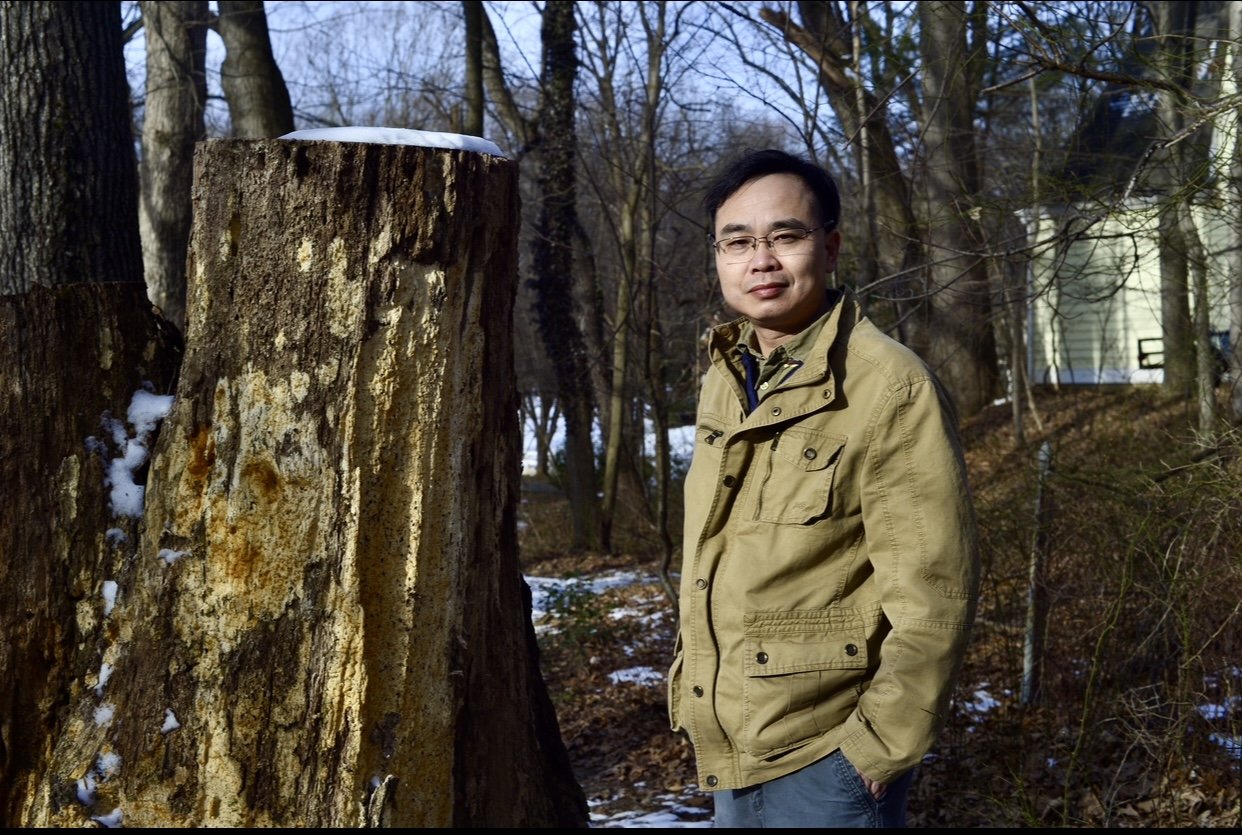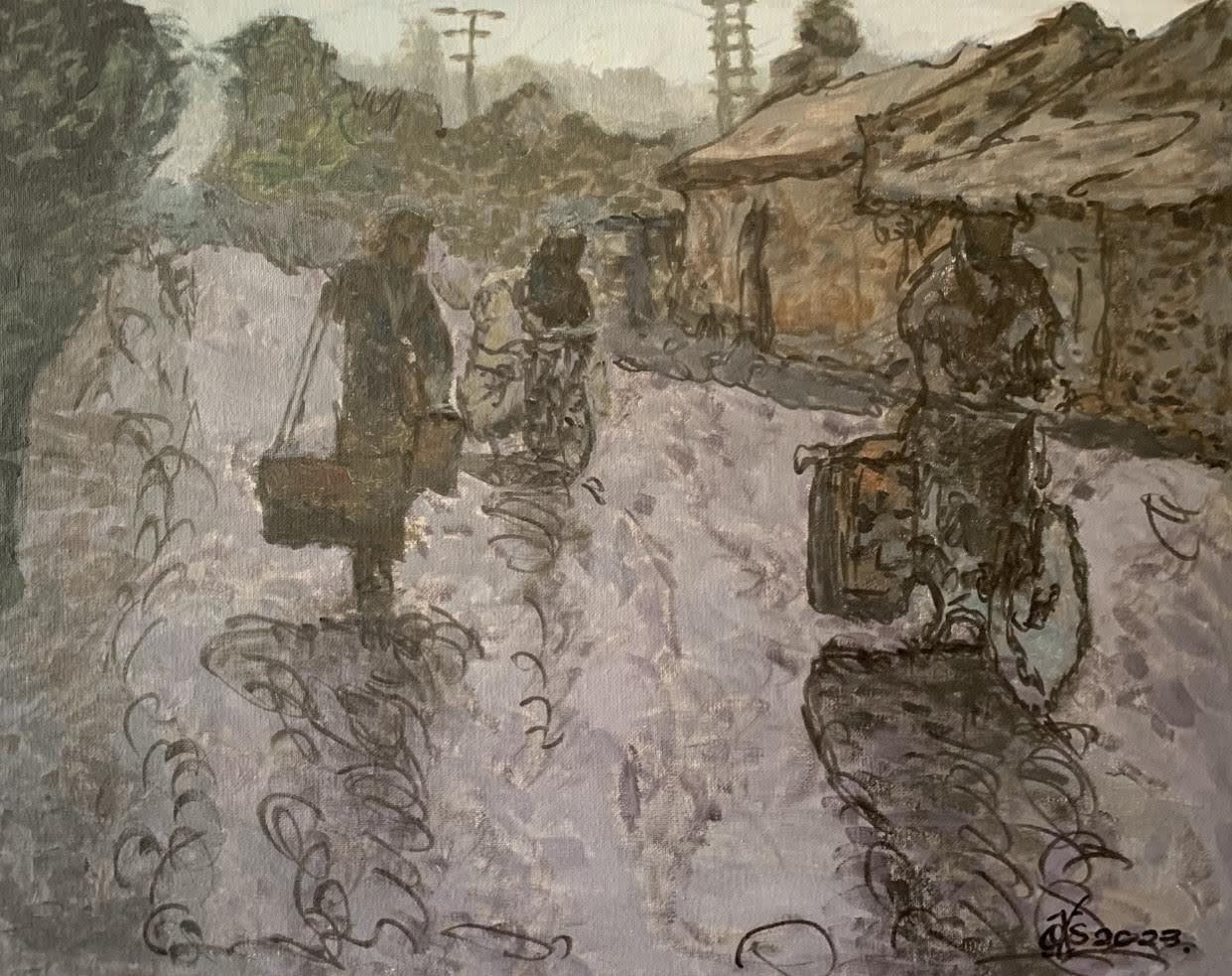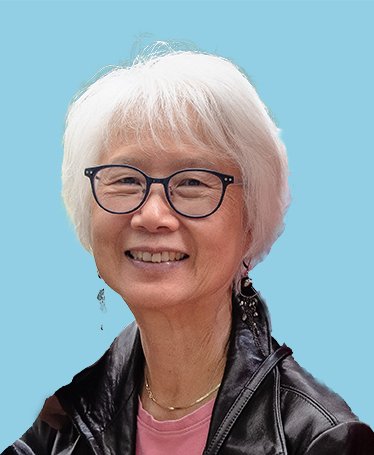ROOTS AND REFLECTIONS: CONTEMPORARY CHINESE ARTISTS IN DC
/Roots and Reflections: Contemporary Chinese Artists in DC
February 1 - April 19, 2024 @ Buchanan Hall Atrium Gallery
Fairfax Campus
Curated by Jeffrey Kenney and Donald Russell
This group exhibition of Chinese American artists has been selected from members of The Chinese Culture and Art League of Washington DC. The artists were originally from Mainland China, Taiwan, and Hong Kong and now live and work in the Greater Washington Area.
The exhibiting artists utilize their deep experience and training in the history of Chinese painting and its techniques while synthesizing new influences and techniques from Western art history and contemporary practice. The works presented are grounded in ancient traditions and propelled by a collective desire among the artists to preserve aspects of Chinese heritage and cultural history through their artworks. From this shared foundation each artist has developed their own distinct artistic voice and offer a diverse set of perspectives, themes and stylistic explorations that blend time-honored techniques with individual experimentation. Together they present a continuum between worlds–attentive to their roots while gathering in and reflecting upon the world around them.
The exhibition offers a rich opportunity to see and experience these diverse and engaging artistic approaches and to appreciate the convergence and exchange of Eastern and Western sensibilities in contemporary art. The achievement of these artists attest to the generative possibilities that come from developing and embodying a connection with traditional craftsmanship while being open and engaged with global perspectives and learning across cultures.
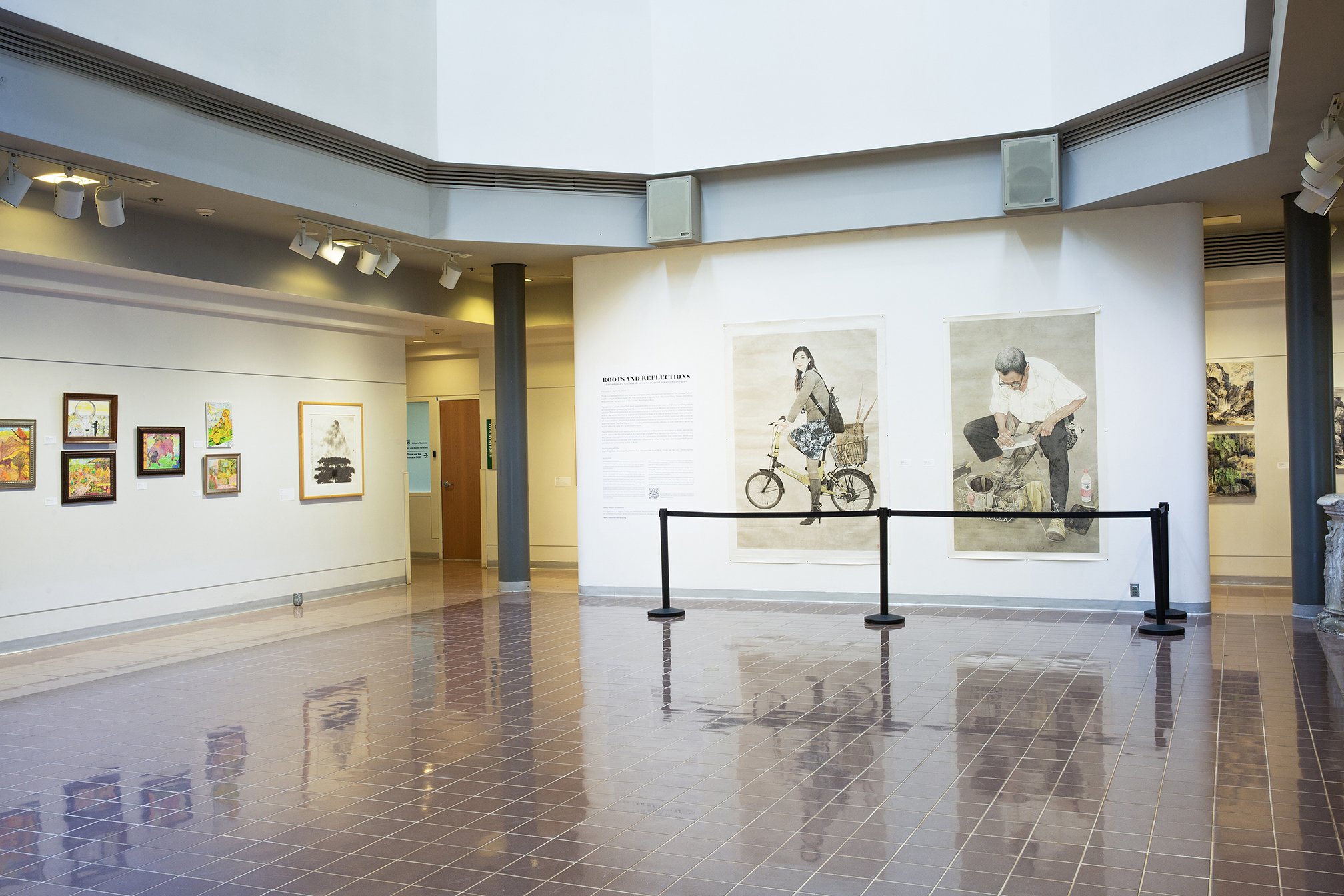
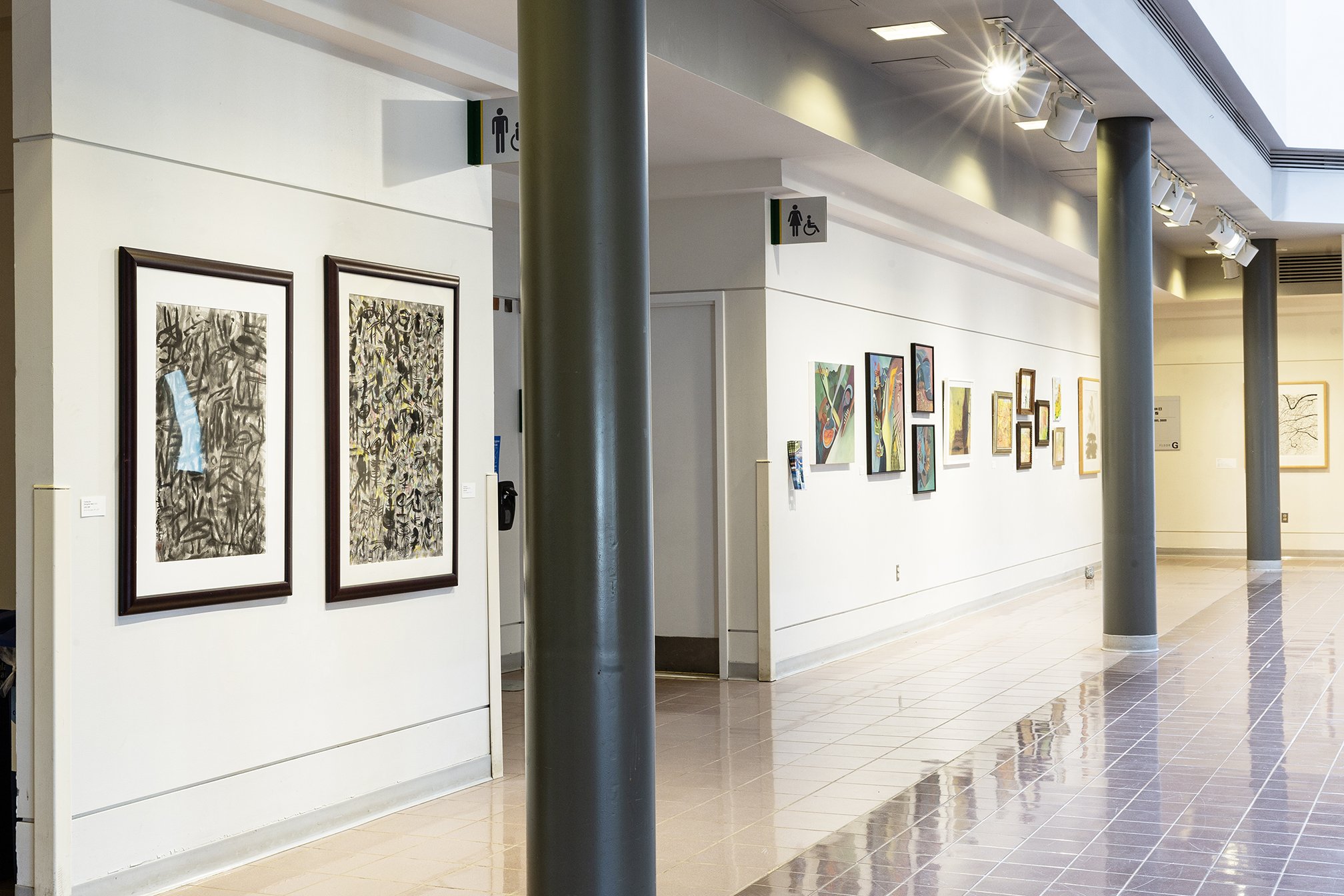
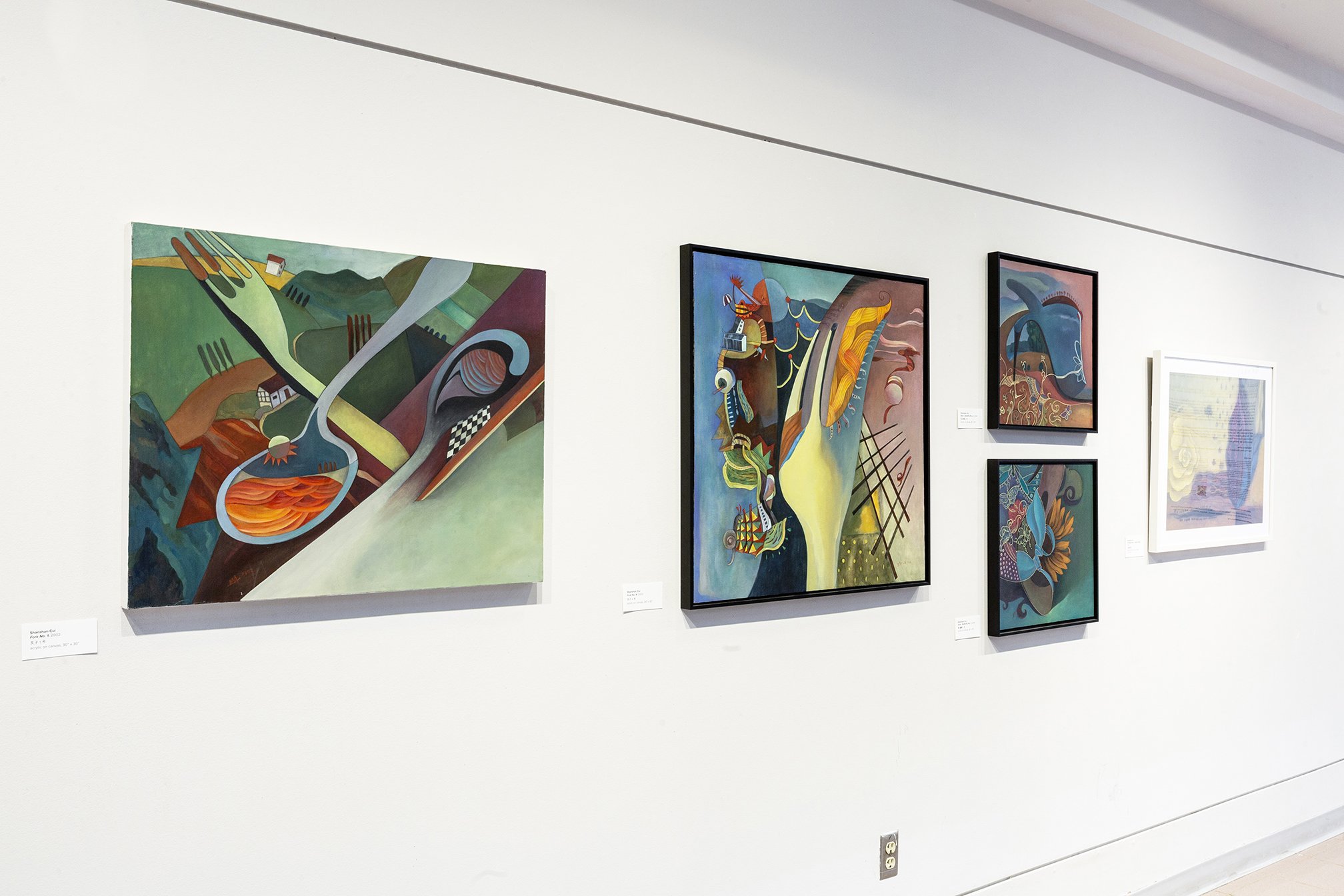

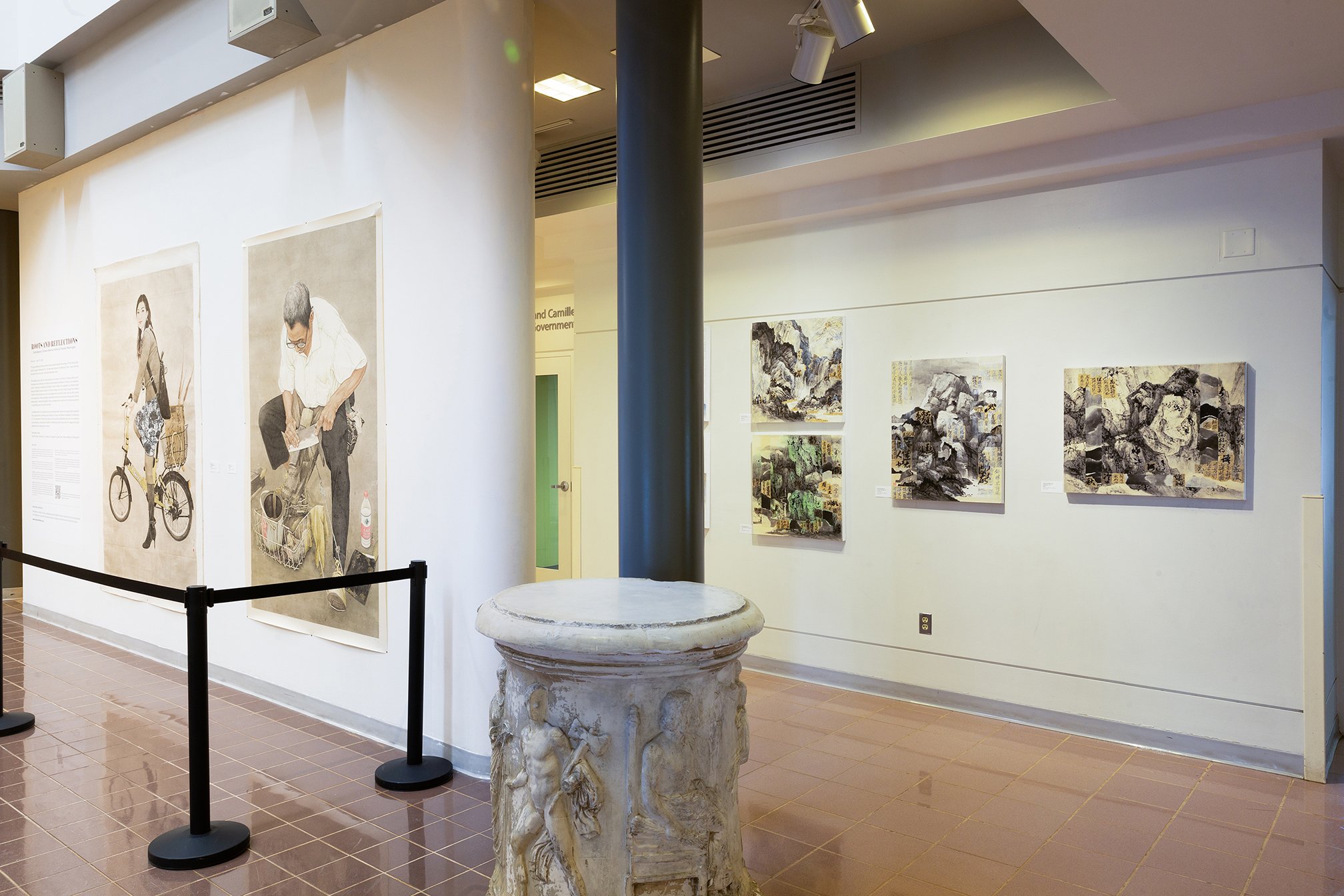
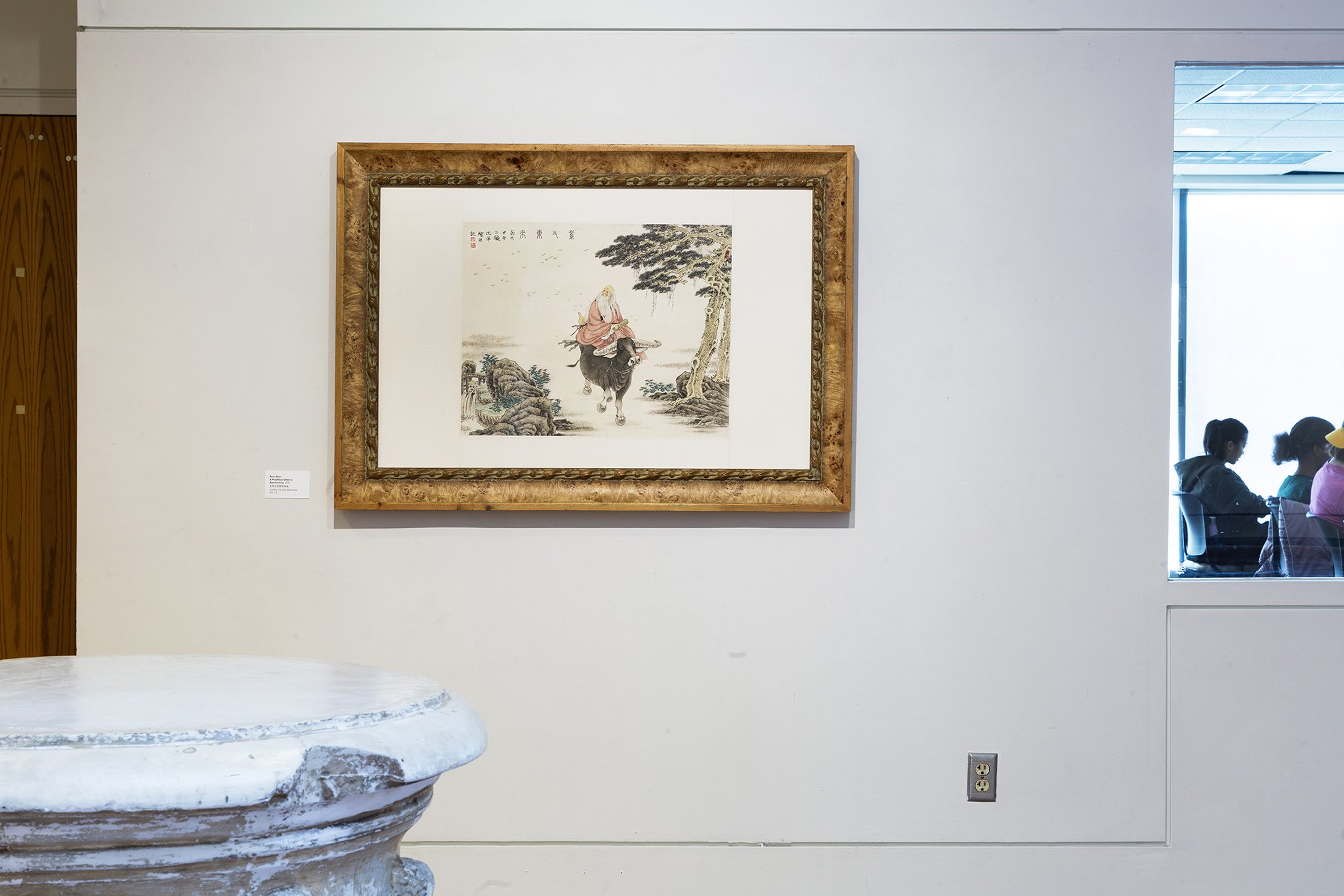
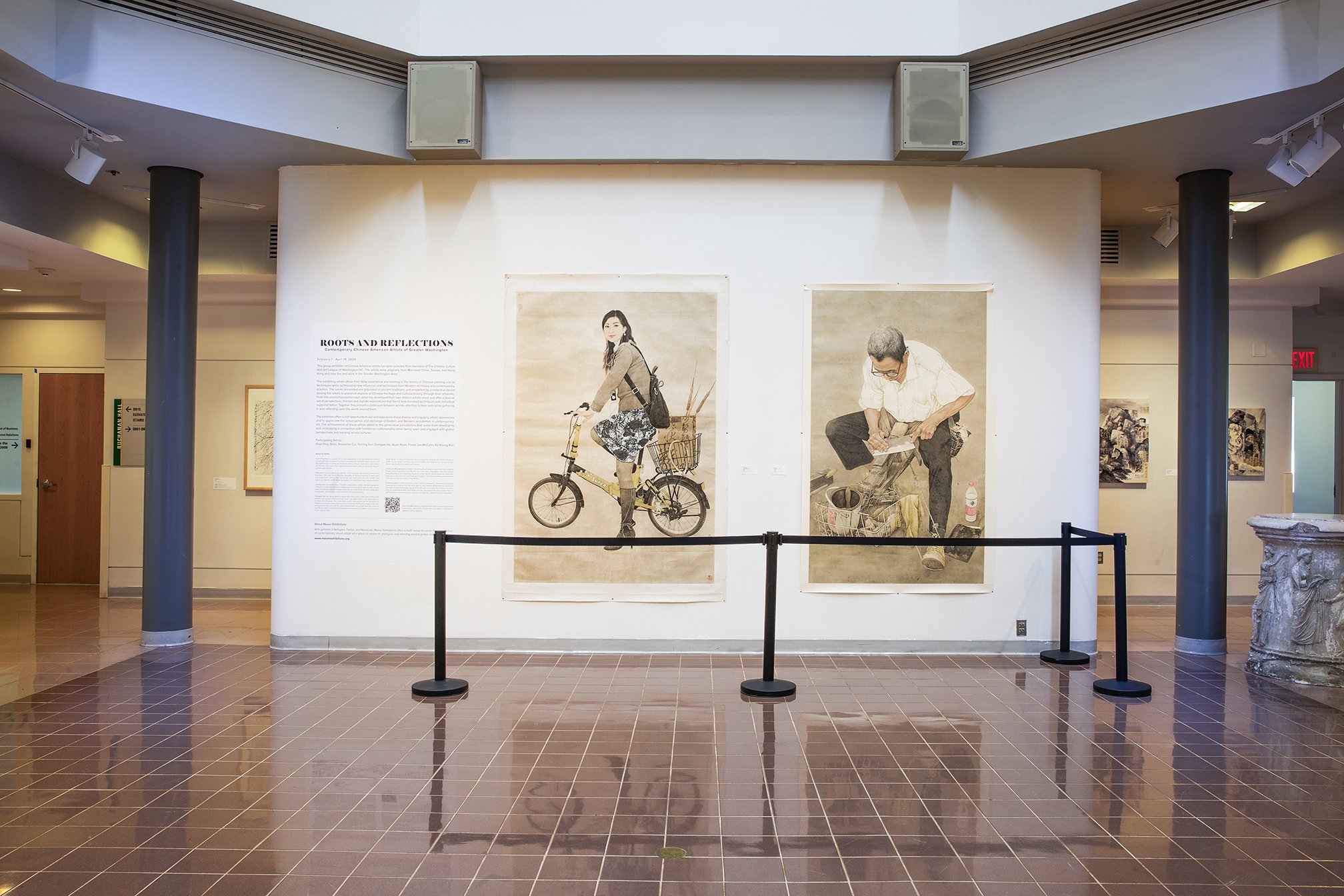
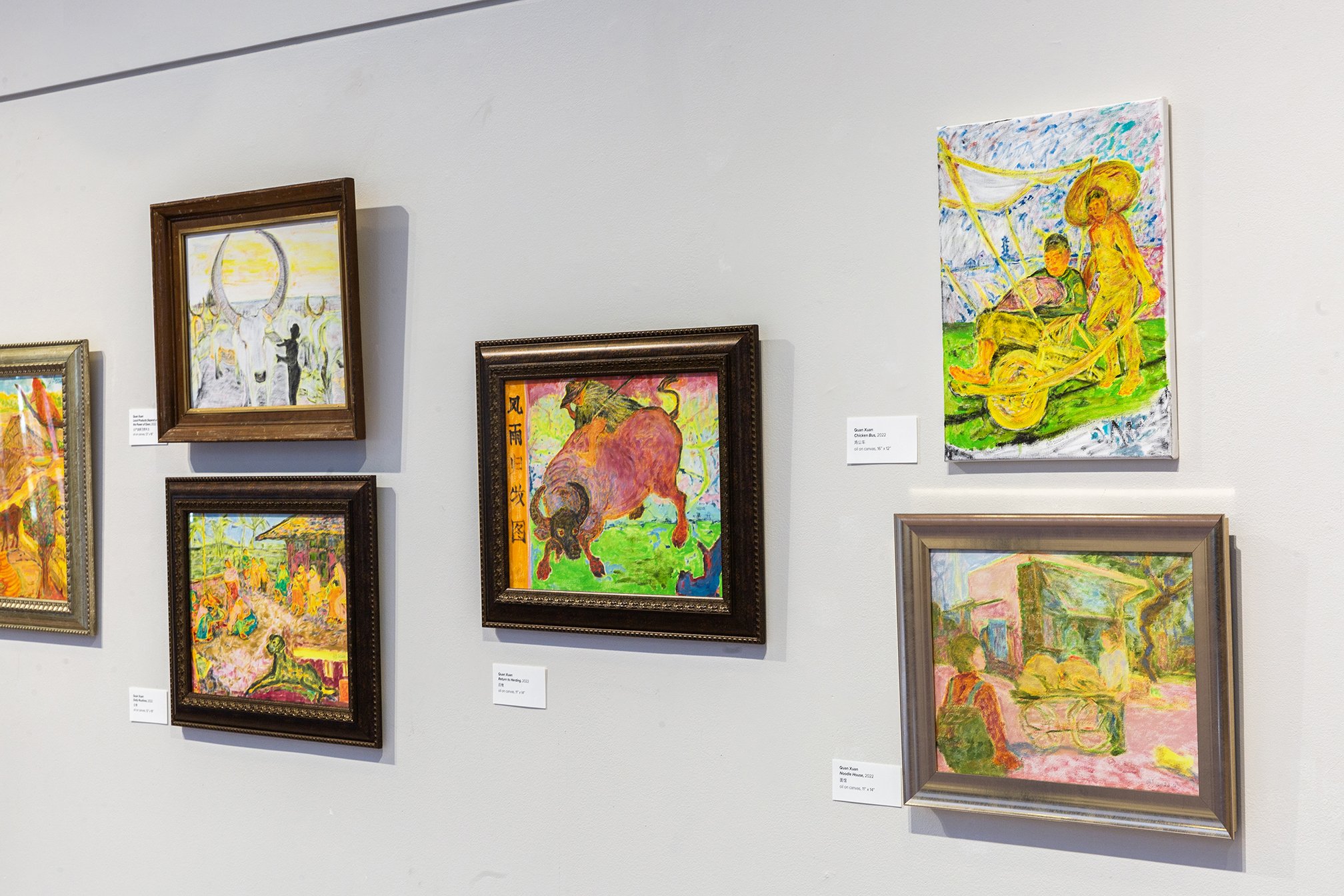
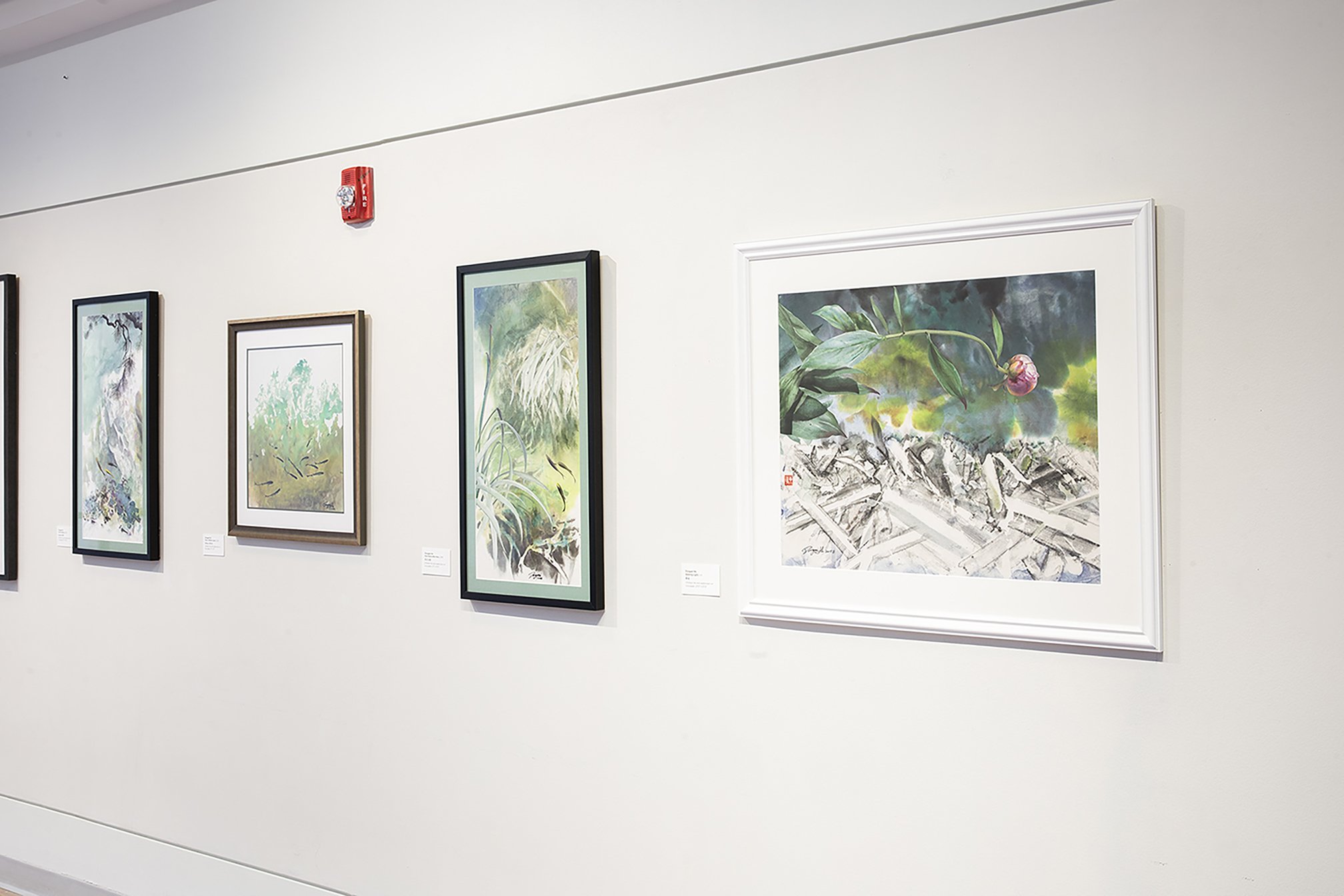
Participating Artists
Shanshan Cui
An Asian woman with dark hair that stops at her jawline. She is wearing dark rectangular glasses with a partial smile. There is a mole above her mouth, and she is wearing a violet and fuscia printed scarf with a gray shirt.
Artistic creation goes beyond perfection and innovation of techniques. It roots in the artists’ cognition on and understanding of life and nature. These paintings registered my stories. They are my reflections on life, death, the world, or dreams. My visual language is complex, using multiple layers of colors and other visual elements. The imageries appear familiar but are mysterious in their synthesis and presentation. The paintings create questions rather than giving answers. I intend to encourage the viewers to make their own interpretations and to complete the story together with me.
An Asian man with clear frameless glasses and silver hardware looking directly into the camera with a big, inviting smile.
Yuming Sun is a well-known Chinese calligrapher, writer, and photographer. He was born in China and studied at Tsinghua University in the 1980’s. During that time, he served as President of the Tsinghua Calligraphy Society and was a member of the Beijing Calligrapher Association. He immigrated to the US in 1991 and currently serves as the vice-president of the Seven Seas Institute of Chinese Calligraphy.
Trained in traditional Chinese calligraphy, but wanting to add his own unique twist, Yuming Sun explored new contemporary ways to let ancient calligraphic art breathe.
First, he uses a dense composition instead of the traditional balanced columns and space. He applies this technique to every script, especially on bronze scripts. With characters connecting to each other, and brush strokes beyond the ordinary square space, he creates a new artistic freedom with an innovative visual effect.
Secondly, he introduces the layer concept to calligraphy. With overlapping thick and light inks, sometimes even combining with dropping colors, he generates not only a special visual effect, but also creates different moods within the artworks. Finally, he utilizes repeated characters to form creating shapes within his works.
Yuming Sun is also a master of seal engraving. In 2021, Xiling Seal Engraver's Society, a prestigious institute in the seal engraving field, published his solo seal album with more than 120 seal artworks.
An Asian woman with clear frameless glasses and long red hair. She is wearing a white tank top and holding a calligraphy brush.
Dongpei He studied at SiChuan Fine Arts Institute in China from 1988 to 1992 and received a B.A degree. She also studied at its affiliate school from 1984 to 1988. She currently is living in Virginia working as a software developer. For the past 15 years, she has been teaching watercolor and Chinese painting to local communities. After coming to the United States, she has been exploring techniques combining traditional Chinese painting and watercolor. She has developed a unique style that gives a new look to the brush strokes and special effects on Xuan Xuan rice paper which is an especially absorbent kind of paper. Her inspiration comes from observing the resilience of flowers and plants as they fight to grow. As a working mother, she too fights to overcome her own challenges. In her daily observation of nature, she finds that she appreciates beauty more in life’s most busy and discouraging moments. The blooming flowers, playful small fish, and peaceful streams that she observes are both an escape from the stress of her life and also a reminder that beauty can be found in unlikely circumstances if you care to look.
An Asian man standing amongst trees and melting snow. He is wearing a tan jacket with his hands in his pockets. He has clear frameless glasses and short black hair, with a slight smile.
Quan Xuan, a native of Sichuan, China, moved to Virginia, the United States in 2018. Exhibition experience: November to December 2015, Dahewan Art Museum, Songzhuang, Beijing, "Circle. Leonardo da Vinci (Shuai Zhong) Personal Exhibition" August 16 to August 20, 2018, San Mei Gallery Art Space, London, UK, Chinese and British Contemporary Art Invitational Exhibition From October 5 to December 5, 2019, "Conversations with Nature-Quanxuan Shuai" solo exhibition at Deville Gallery in Virginia From December 3, 2020 to January 10, 2021, "ATHENAEUM" gallery in Alexandria, personal exhibition.
Rhythm of Nature: Kit-Keung Kan’s Ink Painting, Calligraphy and Installation
by Mary McCoy, artist and art critic July 8, 2023
An Asian man with bright, clear skin, balding grey hair, and wearing glasses with slim black frames and a light green shirt.
Tradition and innovation mingle throughout Kit-Keung Kan’s breathtaking paintings of misty mountains, thundering waterfalls and graceful pine trees and his energetic scrolls of colorful Chinese calligraphy. In this exhibit, Rhythm of Nature: Ink Painting, Calligraphy and Installation, Kan proves himself not only a masterful painter and calligrapher but an engaging poet and philosopher, as well.
A life-long artist who exhibits internationally, he is a retired physicist living in Bethesda. Growing up in China, from an early age he was influenced by traditional Chinese paintings. After moving to the U.S. in 1968 to earn his Ph.D. in physics, he began experimenting with Western ideas in his paintings, exploring semi-abstraction and installation art.
Deeply influenced by traditional Chinese art and philosophy focused on the unity of humans and nature, Kan also loves to experiment with new ideas and has developed his own unique style of painting that is simultaneously realistic and abstract, subtle and stunningly bold. Spare and simple at a glance, his paintings are filled with an infinity of intricate details created by brushing many layers of tiny strokes of Chinese ink and watercolor onto rice paper so that every painting shimmers with activity.
A master calligrapher, Kan is also a poet. Elegantly brushed on both scrolls and paintings, his poems augment his visual images with mental images of landscape. Taking the interplay of painting and poetry yet another step, his dancing strokes of ink appear in installations that hover directly in the viewer’s space, sweeping across the ceiling or dangling from above so that the slightest movement of air sets them in motion.
Pearl Ping Shen
I am expanding art assimilation of an eastern traditional technique into western themes. I create contemporary artworks using traditional Chinese Gongbi painting technique with watercolors on Chinese rice papers.
A craftsman depicts that a craftsman is dedicated to sharpening a knife in a traditional way. Old skills, old tools, and an old man with gray hair and a pale dressing melts in a faded background. The color theme is consistent with ancient paintings and the subject is about traditionally oriental culture. However Kate is an American blonde girl. Her face relaxes into a peace. The red lip, a colorful headscarf, or golden hair does not stand out expressively from dim surroundings. She seems to pass through old times and stand in front of you.
Nowadays the impression about Chinese paintings is mostly from Museums. Actually Gongbi technique is great for contemporary art too and my art is to explore possibilities and creativity.
Artist Website: http://pingshen.weebly.com/about.html
Freda Lee-McCann
An older Asian woman with white hair that frames her face. She is wearing dark round glasses, dangling metal earrings, and a black leather jacket. She has a bright, friendly smile.
After years of painting traditional Chinese landscape, I find that I am moving in a different direction. In the last few years, I have added the calligraphy of famous poems as textures in my work. Although this calligraphy had meaning to me personally, it was used primarily to provide a visual texture to the work, and the poetry itself was not really evident. This use of calligraphy added a new dimension to my landscapes. In my works, I have added two additional elements: poetry and multiple layering.
Multiple-layering is a contemporary concept and not a process used in traditional Chinese paintings. I wanted to experiment with this process. First, I create a basic bottom layer of images or calligraphy on thick rice paper. Then thinner rice paper with images or writing overlay this bottom layer, the image on the heavier paper underneath shows through, and after the layering is completed, some of the image from the layer underneath recedes but does not disappear completely. This process produces a texture and tension in which some of the layers are partially obscured in places, which invites the viewer’s interpretation.
Usually, in a traditional Chinese landscape painting, there are poems written on the painting, sometimes written in beautiful calligraphy by the artist him/herself, a friend or a collector on the blank part of the painting. While I have integrated the calligraphy into my paintings, they are used as collage material and the words are often obscured. In my work (#1, #3) I have selected to copy Mei-Fu’s calligraphy. He is my favorite scholar and calligrapher from the 11th century Sung Dynasty. I love his individual styles of energetic brushwork and dynamic compositional movements. His writing is powerful, graceful and elegant. They are often about friendship and the enjoyable gatherings with friends.
Recently I have discovered a collection of poems written by my Great Uncle Jen Yuan-Tao(任援道). He was a scholar and a general (1890- 1980) who fought in the Chinese Revolution and the civil wars during the early to mid 1900’s. While out on the battlefield in his early 30’s, he wrote many poems inspired by friendship and nostalgia for his family and hometown. In 2011, these poems were published and translated into common Chinese language that I could understand. I found them to be particularly beautiful, sensitive, and meaningful. I decided to incorporate a couple of them into my paintings but not obscure the words; so that the viewers can read them. The calligraphy of the poems was used to create texture and the multi-layering in my work of #1, #4 & #5.
In the most recent work (#6, #8), the landscapes are no longer the main focus, the collages are. The landscape starts at the middle ground, then recedes into the distance, while the collage is in the foreground. There is a transparent layer of written poetry between the landscape and the collage. The poetry is written in very light tone, not necessarily to be read by the viewers. Most of them were written by my Great Uncle. Some of the writings are extracted from Buddha’s script. This gives the landscape a feeling and a memory. The collage pieces are bolder than the landscape - they are abstract shapes from the calligraphy of a poem, often the characters are not recognizable.
Mr. Jen Yuan-Tao (任援道 ) (1890-1980), my great uncle, a scholar and a general, wrote these poems in 1920-24 while he was on the battlefield. I have selected two poems that are from the collection Ch’ing Ping Poems published in 2011. Mr. Jen fought in the Chinese revolutionary war to establish the Republic of China in 1912, and later in the civil war off and on between 1914 and 1928. After a career in the government, he retired in 1947 and moved to Hong Kong and later to Canada.
Celebrating Spring (poem no. 15)
In the early spring, the plum blossoms were blooming with a delicate fragrance, there was snow on the petals. In this beautiful scene Jen could remember an occasion when his poet friends had gathered together to compose many poems. Now he was on the battlefield and missed both his family and his friends. The memories of his hometown made it seem magical and out of this world. By the river bank, the moon was the brightest and the roundest ever, and he thought that he was very tired of being away from home, and he reminisced about chatting with relatives and about how short life was. When one is suffering through bad times, it seems as though they will never end. In a moment of reflection, Jen thinks that the bad times do pass; so, why take life so seriously? Enjoy the moment, get drunk and write poetry with friends under the cherry blossom trees.
十五 慶春澤
標建霞城,香飄雪海,....
故鄉罨畫溪邉月,算今宵、初度光圓。比桃源、洞裡風光,世外神仙。
偶從親戚攀情話,悵浮生如夢,何用相憐。一笑銜杯,相將沉醉梅邊。……
Farewell (poem no. 27)
Farewell is a poem about the sadness Jen felt when his very good friend was leaving to go to war. There was a farewell part going on inside the house, the noise of the guests and music could be heard outside, a sad farewell song was being played. While
Jen was walking with his friend in the garden, there was so much to say to each other that they did not say anything. During this parting, even his friend’s horse could sense the sadness and turned to look back at Jen as they were riding out the gate. It is hard to imagine the pain of leaving one’s home to go to war, and this poem captures the feelings that the two friends had, knowing that they might never see each other again.
二十七 青玉案 (感事)
花驄解意頻迴顧。正綵袖、當筵舞。怕聴陽關三疊句。燕歌悲壯,胡笳淒咽,抵死催人去。
關河冷落秋如許。......
Event Recording
On Monday, March 25 and Thursday, April 18, Mason Exhibitions hosted Chinese Brush Painting and Calligraphy Workshops led by artists Dongpei He and Kit-Keung Kan. Thank you to School of Art Professor Vassiliki Deliyiani for bringing her Drawing students, and Professor Huwymin Liu for bringing her Anthropology students to participate.
















